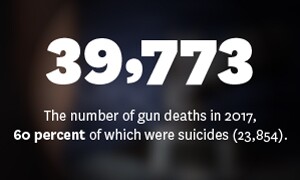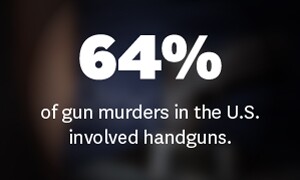What Constitutes a Public Health Issue?
Is gun violence a public health issue? Many Americans would have different answers to this. The truth is, it’s a complicated issue that brings out a lot of passion from each side. There are also political matters and bills that have been passed that have made solving this issue harder. So as we examine if gun violence is a public health issue, we’ll stick to the known facts. Let’s start by defining how our country determines what qualifies as a public health issue.
According to the Center for Disease Control (CDC), “Overall, public health is concerned with protecting the health of entire populations.”1 Among the criteria the CDC utilizes to prioritize public health issues are size and seriousness of the problem, social and economic impact, availability of interventions, and political will to address the issue.2
The data they cite to determine the seriousness of a public health issue is cause-specific mortality data. A cause-specific mortality rate is “the number of deaths from a specified cause per 100,000 person-years at risk.”3 With this in mind, let’s look at the numbers.
Gun Violence Statistics In America
This tends to be where agreement begins and ends for most Americans. The numbers don’t lie, and they don’t have an agenda behind them. The facts are just facts. So here is what the majority of Americans can agree on.
According to the CDC’s most recent reports, there were 39,773 gun deaths in 2017 alone.4
In 2018, there were 426 mass shootings in which 528 people died and more than 1,500 people were injured.5 These mass shootings, like the recent spate that killed 41 people across Texas, California and Ohio in just a little over a month, tend to capture the nation’s attention and headlines, and they draw pleas for reforms and safety measures. But these mass shootings do not make up the majority of gun related deaths we see in the U.S..

Of the 39,773 gun deaths in 2017, 60 percent were suicides (23,854). 37 percent of the gun deaths that year were murders (14,542), and the rest were unintentional, had law enforcement involvement or had indeterminate circumstances.6
Rifles and assault weapons take up much of the mainstream media’s attention, and these firearms have been political talking points in recent years as they seem to be most commonly used in mass shootings. But guns that fall under the category of “rifles” accounted for only four percent of gun deaths in 2017. 64 percent of gun murders in the U.S. involved handguns.6

Of the 19,510 murders in the U.S. in 2017, three quarters (14,542) involved some type of firearm. Of the 47,173 suicides, a little over half (23,854) involved a gun. Gun murders have gone up 32 percent between 2014 and 2017, while gun suicides have risen 41 percent between 2006 and 2017.6
And finally, the cause-specific mortality rate for gun deaths was 12 gun deaths per 100,000 people in 2017, up from 10.6 in 2016.6
How Can We Compare?
We had a lot of numbers in the previous section, and we know that can be overwhelming. But remember, the CDC uses cause-specific mortality rate to help determine the seriousness of a public health issue. 12 gun deaths per 100,000 U.S. citizens in a one-year span may not seem like a lot at face value. But how do we stack up against other countries?
Sometimes it can feel like comparing apples to oranges. The US is one of the largest and wealthiest countries, and we have different laws and different values. We also have more guns per capita than any other country. There are more than 393 million civilian-owned firearms in the United States. According to a Small Arms Survey from the Graduate Institute of International and Development Studies in Geneva, Americans make up four percent of the global population but own 46 percent of the entire world stock of 857 million civilian firearms.7

Our gun related deaths are much higher than those of other countries, particularly developed nations. Our cause-specific mortality rate for gun deaths was 10.6 per 100,000 people in 2016. By comparison, Canada had 2.1, France had 2.7, Australia 1.0, German 0.9, per 100,000 people respectively. The U.S. had a lower rate than El Salvador (39.2) and Colombia (25.9) among others, though. Overall, we ranked 20th in gun fatality rate in 2016.
But the edge we have over developed nations is guns per capita. Other countries may have more restrictive laws or more preventative mental health procedures in place. But when it comes down to it, quantitatively, we simply have more guns than anywhere else in the world. And reducing gun violence in America has become a problem that can’t be fixed with one solution.
More Than Thoughts and Prayers
By the CDC’s own criteria, the size, seriousness, social and economic impact of the problem would certainly make solving gun violence a priority. But it’s the lack of availability of interventions and political will to solve the issue that seem to be holding things back.
A significant roadblock to solving this gun violence public health crisis has been the 1996 Dickey Amendment which stipulates that “none of the funds made available for injury prevention and control at the Centers for Disease Control and Prevention [CDC] may be used to advocate or promote gun control.”8
In 1993, Arthur Kellermann and his colleagues found an increased risk of homicide associated with the presence of a firearm in a home. This study, along with similar published research, captured media attention and struck a nerve with the National Rifle Association (NRA). The NRA accused the CDC of being biased and began to lobby for the elimination of the CDC’s injury prevention center. The injury prevention center survived, but the NRA and its supporters in Congress, led by Representative Jay Dickey of Arkansas, were successful in prohibiting the CDC from using funds to promote gun control. They went a step further and stipulated that the $2.6 million the CDC used for firearm injury research in 1995 would be specifically used for traumatic brain injury research.9
The Dickey Amendment is still in effect, which means the CDC is still prohibited from advocating for gun control measures, in spite of facts and figures pointing towards an epidemic. Dickey has come out recently and expressed regret that his amendment caused all gun and gun ownership research to cease. He believes that in the time we’ve had since the passing of his amendment, we would have found a solution to the gun violence problem and called for Congress to “reactivate that fund and be specific as to what that money is to be used for.”10
And to that end, there has been a bill introduced to Congress in February of this year that would require the Surgeon General to submit annual reports to Congress on the public health effects of gun violence, as well as reports on the status of actions to address those effects.11 Science does not determine policy, but it should help inform policy, and this measure could bring us one step closer to giving our country a solution to the gun violence public health issue of gun violence.
Be a Part of the Solution
Kent State University’s online graduate programs in public health provide students with a powerful environment in which to examine and study some of the most challenging and complex public health issues we face, including gun violence and its impact on our society.
Explore the vast importance of understanding public health and its impact and consider how an online Master of Public Health could help you lead new conversations about how to solve our most pressing issues.
- Retrieved on October 9, 2019, from cdcfoundation.org/what-public-health
- Retrieved on October 9, 2019, from cdc.gov/globalhealth/healthprotection/fetp/training_modules/4/Prioritize-Problems_FG_Final_09262013.pdf
- Retrieved on October 9, 2019, from www-doh.state.nj.us/doh-shad/view/sharedstatic/CauseSpecificDeathRate.pdf
- Retrieved on October 9, 2019, from cdc.gov/nchs/fastats/injury.htm
- Retrieved on October 9, 2019, from massshootingtracker.org/data/2018
- Retrieved on October 9, 2019, from pewresearch.org/fact-tank/2019/08/16/what-the-data-says-about-gun-deaths-in-the-u-s/
- Retrieved on October 9, 2019, from washingtonpost.com/news/wonk/wp/2018/06/19/there-are-more-guns-than-people-in-the-united-states-according-to-a-new-study-of-global-firearm-ownership/
- Retrieved on October 9, 2019, from jamanetwork.com/journals/jama/fullarticle/2595514
- Retrieved on October 9, 2019, from ncbi.nlm.nih.gov/pmc/articles/PMC5993413/
- Retrieved on October 9, 2019, from npr.org/2015/10/09/447098666/ex-rep-dickey-regrets-restrictive-law-on-gun-violence-research
- Retrieved on October 9, 2019, from congress.gov/bill/116th-congress/house-bill/1114?q=%7B%22search%22%3A%221114%22%7D&r=2&s=1
